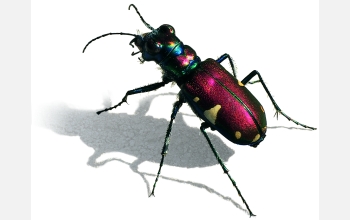Multimedia Gallery
Tiger beetle species (Cicindela pulchra)
Tiger beetle species Cicindela pulchra, photographed at Wilcox Playa, Ariz. Tiger beetles stand out because of their bright colors and interesting markings.
More about tiger beetles:
Tiger beetles (family Cicindelidae) are a type of arthropod, a group that includes all insects, crustaceans and arachnids. There are about 2,300 species of tiger beetles. With the exception of Antarctica, Tasmania and a few of the most remote oceanic islands, tiger beetles are found everywhere on Earth where there is land.
Tiger beetles live primarily in tropical areas, but the United States is home to 120 different species. There are 36 species living in the state of Arizona alone! Eighteen different species live in the Sulphur Springs Valley in southeastern Arizona--one of the highest concentrations of species in all of North America.
Most tiger beetles are brown or green with stripes, but some species are stunningly decorated in metallic green, brown, maroon or purple, often with stripes or spots. They vary greatly in size. The smallest species lives in Borneo and is about the length of a housefly. The largest lives in southern Africa and can measures up to 45 millimeters. Species found in Arizona range from 10 to 25 millimeters in length.
All tiger beetles have long, thin mandibles shaped like sickles, which help them capture prey. The beetle larvae use their mandibles to dig tunnels in the ground, where they wait for small insects to pass close enough for capture. The larvae stay in their tunnels from one to three years before emerging as adult beetles.
Tiger beetles are swift. An Australian tiger beetle species is the fastest running of all arthropods. It can move 9 kilometers per hour (5.6 miles per hour). Tigers use this speed to capture prey. All desert tigers use their excellent eyesight to locate prey and their amazing speed to run it down.
Some conservation biologists have taken an interest in these colorful predators as bioindicators. A bioindicator is a species that serves as a representative sample of its ecosystem and a monitor of environmental change. Tiger beetles make excellent bioindicators because they are highly sensitive to changes in their environment. (Year of image: 1995)
Credit: Kim Wismann
Special Restrictions: Use of this image has been restricted by the owner. Permission is granted to use this image for personal, educational and nonprofit/non-commercial purposes only, and only after sending an email notifying your intent to use the image to Kim Wismann at kim.wismann@asu.edu. Permission to use this image in any other manner is strictly prohibited without prior permission from the owner.
Images and other media in the National Science Foundation Multimedia Gallery are available for use in print and electronic material by NSF employees, members of the media, university staff, teachers and the general public. All media in the gallery are intended for personal, educational and nonprofit/non-commercial use only.
Images credited to the National Science Foundation, a federal agency, are in the public domain. The images were created by employees of the United States Government as part of their official duties or prepared by contractors as "works for hire" for NSF. You may freely use NSF-credited images and, at your discretion, credit NSF with a "Courtesy: National Science Foundation" notation.
Additional information about general usage can be found in Conditions.
Also Available:
Download the high-resolution TIFF version of the image. (9.8 MB)
Use your mouse to right-click (Mac users may need to Ctrl-click) the link above and choose the option that will save the file or target to your computer.



